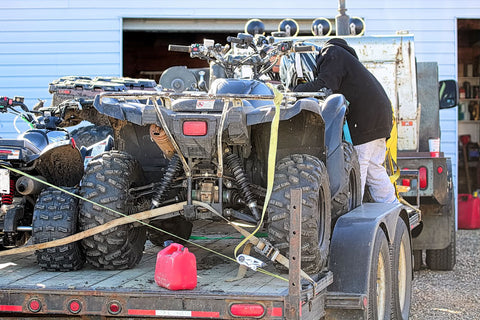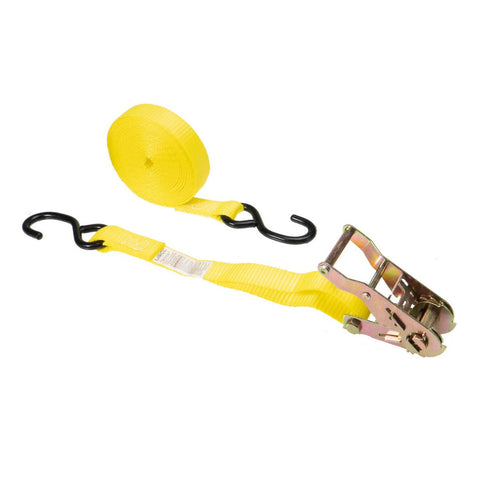
How to Prepare Your Trailer for ATV Riding
Spring weather means warmer temperatures, longer days, and riding around on your ATVs and UTVs! Before you start riding and tearing up dirt trails with your four-wheelers or side-by-side's on your next big trip, you'll want to make sure you have the right trailer setup to transport your ATV or UTV safely.
We break down how to load up your powersports vehicle properly, what tie down supplies and enclosed trailer setup you need, and other items to inspect before riding off on your ATV.
ATV Trailer Setup - Enclosed or Flatbed Trailers
Safety is imperative when transporting your ATV or UTV. Without the right equipment or trailer setup, you risk damaging your vehicle, your ATV trailer, or potentially causing an accident on the road. To ensure your ATV stays in place, you need:
- Trailer - large enough to fit your powersports vehicle.
- Truck - needs to handle the load of your trailer as well as the weight of your ATV or UTV.
- Tie Down Supplies - there are specific straps suited for tying down these types of vehicles.
The most common trailer types to haul ATVs are short flatbed trailers that have a drop-down ramp at the end for easy accessibility and transport security. These can be short trailers pulled by light- or medium-duty pickup trucks, or for the serious haulers, long step deck trailers hauled by heavy-duty trucks or semis. Otherwise, people also haul their ATVs in enclosed van trailers to keep them safe from road debris or other elements during transit.
- Shop by trailer type for the right tie down equipment!
Before loading up your ATVs, first you want to check the condition of your trailer and look for any damages or areas that need fixing. Does the frame and axle of your trailer look good? Do your tires need pumping or replacing? Any trailer decking that needs repairing before parking your ATV on it for transport? Ask yourself these questions and make sure you do a top-down inspection of your trailer.

How to Tie Down Your ATV to Your Trailer
- Park the ATV/UTV on the trailer. Your vehicle should be right on the axle of your trailer to keep the weight evenly distributed.
- Apply tie downs to the vehicle. With ATV straps, take the loose ends of each one and wrap them through the frame of the ATV. Never wrap them around the axle or other part that's exposed to movement. The tightening process can cause these parts to bend or break.
- Pull any remaining slack out through the ratchet.
- Ratchet to tighten. Make sure to hold the ratchet strap end tightly when doing so.
- Take care of loose strap. Wrap the excess webbing around the taut strap to prevent it from billowing during transit.
ATV & UTV Tie Down Supplies
Choosing the right tie down makes the process much easier. With ATV/UTV tie down straps, you get ratchet straps that are suited to fit through ATVs while maintaining their tie down strength. All ATV tie down straps are made with a durable 1-2" wide polyester webbing that's strong and has a low-stretch factor to keep your vehicle in place on your trailer.
- Get more tie down options with our Ratchet Straps!

The length of your tie down strap depends on a couple of factors: (1) the width of your trailer and (2) the size of your ATV/UTV. Be sure to choose the length that will allow you to reach the anchor point of your trailer to the frame of your vehicle. It's better to caution on the longer side than come up too short.
These tie downs also have different end fitting options to choose from. ATV/UTV tie down straps are made with end fittings that connect to many different anchor points and systems, including D-Rings, L-Track stud fittings, and E-Track.
Finally, when using these tie down straps, read up on the safety tag information detailing their working load limits and breaking strength. It's always important to use straps within their limits so you don't break the strap or put your load into harm's way.

Inspecting Your ATV Before Riding
Besides setting up your trailer, take a look at your ATV or UTV before riding. Here are a few things to consider inspecting:
1. Check for Leaks
Let your ATV/UTV run and see if you notice any leaks. This is a big issue if left untreated, so be on the look out for any signs of fluid leaks or oil leakage. Once any potential leaks are patched up, it's important to check your fluid levels, get an oil change, and inspect your filters before you head out on your ride to ensure everything's running smoothly.
2. Check Your Battery
Check your battery's performance before riding. You wouldn't want to be stranded in the middle of nowhere with a dead or faulty battery. Replace it as needed.
3. Check Tire Pressure
Air up your tires to their necessary levels. If your tires are worn from previous riding, then you may want to consider replacing them.
4. Inspect Brakes
Be on the lookout for faulty or worn brakes and brake pads. If you feel your brakes grinding or not being fully responsive, have them checked out immediately.
5. Update Tags and Registration
Finally, your ATV/UTV should be registered and updated before riding, especially on public trails. This includes registration, insurance, and any other permits.

Safe ATV Riding & Towing
While riding in ATVs and UTVs can be a fun activity, it can also be a very dangerous one when taken for granted. According to a 2021 report from the U.S. Consumer Product Safety Commission (CPSC), ATV and UTV accidents have gone up with a sizeable share correlating to accidents involving young adults and teenagers. If you're driving any of these off-road vehicles, then you need to play by the rules and keep you and others around you free from harm.
To stay safe while riding in an ATV or UTV, follow these tips listed below:
- Always wear a helmet.
- Wear other protective gear like goggles and long-sleeved clothing to protect your eyes and body.
- Steer clear of paved public roads. You'll increase the likelihood of a vehicle crashing into you.
- Never ride alone in case you wind up in an accident or roll-over.
- Always stay sober when driving.
- Only ride with the amount of passengers allowed for your powersports vehicle. Never ride with too many passengers.
More Articles You May Like:
10 Cargo Control Items Used by Farmers
How to Create a Motorcycle Tie Down System with L-Track
Which Car Tie Down Strap is Right for Me?
Working Load Limit, Breaking Strength, & Safety Factor: What Do They Mean?



